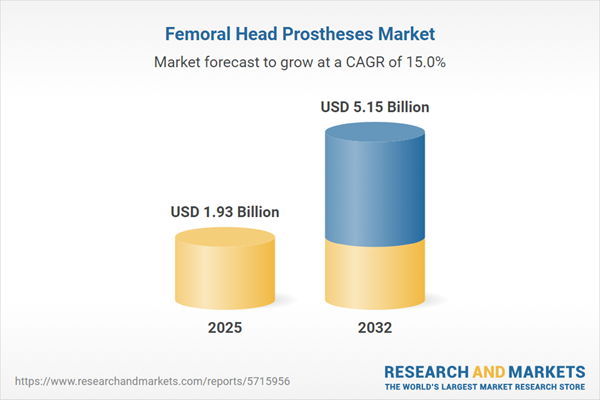Speak directly to the analyst to clarify any post sales queries you may have.
Senior decision-makers in the femoral head prosthesis market face ongoing regulatory evolution, rapid technological advancements, and a persistent drive for operational efficiency. This summary offers targeted, actionable insights to help leaders achieve strategic advantage in the competitive orthopedic device sector.
Market Snapshot: Femoral Head Prosthesis Market Overview
The femoral head prosthesis market demonstrates steady growth, propelled by continuous developments in biomaterial science and refined surgical techniques. Widening access to orthopedic procedures in established and emerging economies is increasing device adoption, fortifying the market’s resilience. Advancements in implant engineering are supporting faster patient recoveries and enhancing surgical results. Industry-wide collaboration between manufacturers, healthcare professionals, and regulators supports higher standards and ensures global policy alignment. These factors define a dynamic, evolving orthopedic device landscape.
Femoral Head Prosthesis Market Scope & Segmentation
The market encompasses complex frameworks shaped by regulatory change, innovations in materials, and clinical adoption across global regions. Strategic segmentation improves investment decisions, fosters targeted innovation, and ensures compliance within this multifaceted environment. Key segments include:
- End User: Both hospitals and ambulatory surgical centers rely on prostheses, with solutions tailored to distinct patient demographics and specific clinical requirements.
- Fixation Method: Cemented and cementless options allow adaptable treatment plans, addressing anatomical variability and surgical preference.
- Distribution Channel: Direct sales, distributor partnerships, and digital procurement processes support stable supply and reliable sourcing for healthcare providers in diverse settings.
- Product Type: Bipolar and unipolar prostheses are used for a range of clinical scenarios, from trauma interventions to standard hip replacements, providing broad applicability.
- Material: Recent innovations cover ceramics such as alumina and zirconia, advanced composites including carbon fiber and PEEK, traditional metals like titanium and cobalt-chromium, and enhanced polyethylene, each improving implant safety and longevity.
- Regions: North and South America, EMEA, and Asia Pacific each exhibit unique market drivers, regulation, and adoption rates shaped by local policies and reimbursement systems.
- Leading Companies: Market participants such as DePuy Synthes, Zimmer Biomet, Stryker, Smith & Nephew, Corin Group, MicroPort Scientific, Exactech, DJO, B. Braun Melsungen, and Globus Medical lead advancements and broaden access to orthopedic solutions.
Understanding these dimensions supports strategic resource allocation, compliance resilience, and integration of new technologies across clinical environments.
Key Takeaways for Senior Decision-Makers
- Emerging ceramic and composite materials are influencing procurement and supplier assessment, underscoring the importance of evaluating long-term implant outcomes.
- Prosthesis designs optimized for ambulatory surgical centers reflect ongoing healthcare delivery shifts, enabling smoother transitions and continuity of care for patients.
- Diversified product portfolios and comprehensive support services facilitate wider adoption and collaboration among orthopedic teams.
- Digital procurement platforms are improving operational consistency and standardizing onboarding processes for large healthcare networks.
- Global market expansion requires agile compliance strategies, with local adaptation to reimbursement and care delivery requirements.
- Continual product refinement and robust clinical evidence are essential for building confidence and long-term partnerships within the orthopedic segment.
Tariff Impact on U.S. Manufacturing and Global Supply
Recent changes in U.S. tariffs on implant-grade titanium and cobalt-chromium have prompted companies to diversify their supply base and expand domestic manufacturing. Organizations are prioritizing risk management and investing in measures that ensure cost-effective and reliable supply chains amid evolving trade policies.
Research Methodology & Data Sources
This study integrates insights from orthopedic surgeons, device engineers, and procurement experts through in-depth interviews. All findings are validated with industry data, ensuring the content aligns with practical requirements for executive-level decision-making.
Why This Report Matters
- Clarifies the impact of regulatory adjustments and changing clinical protocols, enabling senior leaders to shape agile product strategies in the femoral head prosthesis market.
- Delivers operational guidance for effective procurement and global vendor management in the constantly evolving orthopedic sector.
- Supports risk mitigation efforts and responsible technology adoption to drive sustainable, long-term market presence.
Conclusion
This report guides senior executives through market complexities, empowering informed decisions and supporting successful navigation of innovation and regulatory demands in the femoral head prosthesis sector.
Additional Product Information:
- Purchase of this report includes 1 year online access with quarterly updates.
- This report can be updated on request. Please contact our Customer Experience team using the Ask a Question widget on our website.
Table of Contents
3. Executive Summary
4. Market Overview
7. Cumulative Impact of Artificial Intelligence 2025
Companies Mentioned
The companies profiled in this Femoral Head Prostheses market report include:- DePuy Synthes, Inc.
- Zimmer Biomet Holdings, Inc.
- Stryker Corporation
- Smith & Nephew PLC
- Corin Group Ltd
- MicroPort Scientific Corporation
- Exactech, Inc.
- DJO, LLC
- B. Braun Melsungen AG
- Globus Medical, Inc.
Table Information
| Report Attribute | Details |
|---|---|
| No. of Pages | 190 |
| Published | November 2025 |
| Forecast Period | 2025 - 2032 |
| Estimated Market Value ( USD | $ 1.93 Billion |
| Forecasted Market Value ( USD | $ 5.15 Billion |
| Compound Annual Growth Rate | 14.9% |
| Regions Covered | Global |
| No. of Companies Mentioned | 11 |









